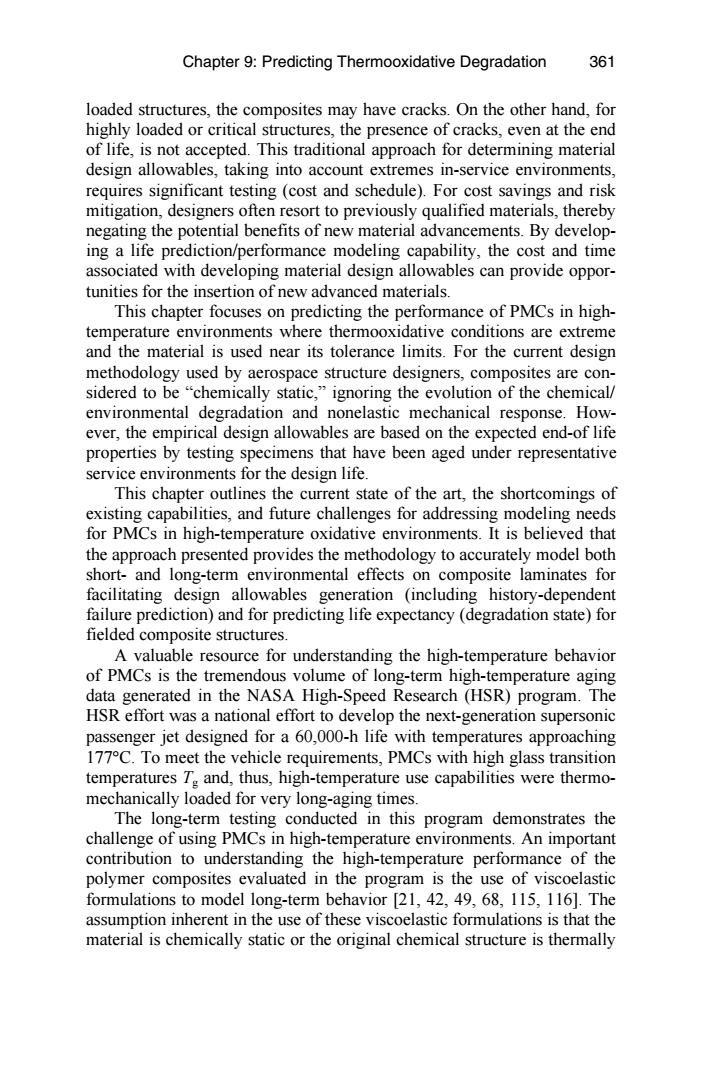正在加载图片...

Chapter 9:Predicting Thermooxidative Degradation 361 loaded structures,the composites may have cracks.On the other hand,for highly loaded or critical structures,the presence of cracks,even at the end of life,is not accepted.This traditional approach for determining material design allowables,taking into account extremes in-service environments, requires significant testing (cost and schedule).For cost savings and risk mitigation,designers often resort to previously qualified materials,thereby negating the potential benefits of new material advancements.By develop- ing a life prediction/performance modeling capability,the cost and time associated with developing material design allowables can provide oppor- tunities for the insertion of new advanced materials. This chapter focuses on predicting the performance of PMCs in high- temperature environments where thermooxidative conditions are extreme and the material is used near its tolerance limits.For the current design methodology used by aerospace structure designers,composites are con- sidered to be "chemically static,"ignoring the evolution of the chemical/ environmental degradation and nonelastic mechanical response.How- ever,the empirical design allowables are based on the expected end-of life properties by testing specimens that have been aged under representative service environments for the design life. This chapter outlines the current state of the art,the shortcomings of existing capabilities,and future challenges for addressing modeling needs for PMCs in high-temperature oxidative environments.It is believed that the approach presented provides the methodology to accurately model both short-and long-term environmental effects on composite laminates for facilitating design allowables generation (including history-dependent failure prediction)and for predicting life expectancy(degradation state)for fielded composite structures. A valuable resource for understanding the high-temperature behavior of PMCs is the tremendous volume of long-term high-temperature aging data generated in the NASA High-Speed Research (HSR)program.The HSR effort was a national effort to develop the next-generation supersonic passenger jet designed for a 60,000-h life with temperatures approaching 177C.To meet the vehicle requirements,PMCs with high glass transition temperatures T and,thus,high-temperature use capabilities were thermo- mechanically loaded for very long-aging times. The long-term testing conducted in this program demonstrates the challenge of using PMCs in high-temperature environments.An important contribution to understanding the high-temperature performance of the polymer composites evaluated in the program is the use of viscoelastic formulations to model long-term behavior [21,42,49,68,115,116].The assumption inherent in the use of these viscoelastic formulations is that the material is chemically static or the original chemical structure is thermallyloaded structures, the composites may have cracks. On the other hand, for highly loaded or critical structures, the presence of cracks, even at the end of life, is not accepted. This traditional approach for determining material design allowables, taking into account extremes in-service environments, requires significant testing (cost and schedule). For cost savings and risk mitigation, designers often resort to previously qualified materials, thereby negating the potential benefits of new material advancements. By developing a life prediction/performance modeling capability, the cost and time associated with developing material design allowables can provide opportunities for the insertion of new advanced materials. This chapter focuses on predicting the performance of PMCs in hightemperature environments where thermooxidative conditions are extreme and the material is used near its tolerance limits. For the current design This chapter outlines the current state of the art, the shortcomings of existing capabilities, and future challenges for addressing modeling needs for PMCs in high-temperature oxidative environments. It is believed that the approach presented provides the methodology to accurately model both short- and long-term environmental effects on composite laminates for facilitating design allowables generation (including history-dependent failure prediction) and for predicting life expectancy (degradation state) for fielded composite structures. A valuable resource for understanding the high-temperature behavior of PMCs is the tremendous volume of long-term high-temperature aging data generated in the NASA High-Speed Research (HSR) program. The HSR effort was a national effort to develop the next-generation supersonic passenger jet designed for a 60,000-h life with temperatures approaching 177°C. To meet the vehicle requirements, PMCs with high glass transition temperatures Tg and, thus, high-temperature use capabilities were thermomechanically loaded for very long-aging times. The long-term testing conducted in this program demonstrates the challenge of using PMCs in high-temperature environments. An important contribution to understanding the high-temperature performance of the polymer composites evaluated in the program is the use of viscoelastic formulations to model long-term behavior [21, 42, 49, 68, 115, 116]. The assumption inherent in the use of these viscoelastic formulations is that the material is chemically static or the original chemical structure is thermally methodology used by aerospace structure designers, composites are considered to be “chemically static,” ignoring the evolution of the chemical/ environmental degradation and nonelastic mechanical response. However, the empirical design allowables are based on the expected end-of life properties by testing specimens that have been aged under representative service environments for the design life. Chapter 9: Predicting Thermooxidative Degradation 361